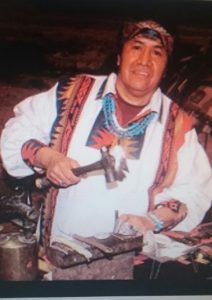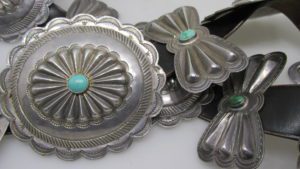 First of all, the Navajo, or Diné, begin working silver in the 19th century. Most noteworthy, Atsidi Sani, or “Old Smith,” (c. 1828-1918) may be the first Navajo blacksmith Correspondingly, he may be the first Navajo silversmith. Consequently, he learns to work silver from a Mexican smith as early as 1853. As a result, Navajo metalsmiths make buckles, bridles, buttons, rings, canteens. In addition, they make hollow beads, earrings, crescent-shape pendants (“najas”), and bracelets. In addition, they make crosses, powder chargers, tobacco canteens. Also, they make disks aka “conchas” or conchos”. These typically decorate belts, made from copper, steel, iron, and silver.
First of all, the Navajo, or Diné, begin working silver in the 19th century. Most noteworthy, Atsidi Sani, or “Old Smith,” (c. 1828-1918) may be the first Navajo blacksmith Correspondingly, he may be the first Navajo silversmith. Consequently, he learns to work silver from a Mexican smith as early as 1853. As a result, Navajo metalsmiths make buckles, bridles, buttons, rings, canteens. In addition, they make hollow beads, earrings, crescent-shape pendants (“najas”), and bracelets. In addition, they make crosses, powder chargers, tobacco canteens. Also, they make disks aka “conchas” or conchos”. These typically decorate belts, made from copper, steel, iron, and silver.
 Furthermore, early Navajo smiths rocker-engrave, stamp, and file designs into plain silver. This silver originates from coins, flatware, and ingots. Later, they obtain metal from European-American traders. In due time, they acquire sheet silver and wire from American settlers. As a result, the punches and stamps of Mexican leather workers become the first tools to create these decorations. Still later, railroad spurs, broken files, iron scraps and, later, piston rods become handmade stamps. In addition, commercially-made stamps become available. In addition, these silversmiths use several other traditional hand tools, being relatively simple to construct.
Furthermore, early Navajo smiths rocker-engrave, stamp, and file designs into plain silver. This silver originates from coins, flatware, and ingots. Later, they obtain metal from European-American traders. In due time, they acquire sheet silver and wire from American settlers. As a result, the punches and stamps of Mexican leather workers become the first tools to create these decorations. Still later, railroad spurs, broken files, iron scraps and, later, piston rods become handmade stamps. In addition, commercially-made stamps become available. In addition, these silversmiths use several other traditional hand tools, being relatively simple to construct.
The bellows consists of a skin bag about a foot long, held open with wooden hoops. Furthermore, it has a valve and a nozzle. Silversmiths use a forge, crucibles, an anvil, and tongs during the melting process. In addition, molds, the matrix and die, cold chisels, scissors, pliers, files, awls, and emery paper also come into play. Most notably, a silversmith uses a soldering setup, consisting of a blowpipe and a torch made of oil-soak rags along with borax. Also, the silversmith uses a grinding stone, sandstone dust, and ashes for polishing the jewelry, and a salt called almogen is used for whitening. Additionally, Navajo jewelers begin sand casting silver around 1875. Consequently, they melt silver and pour it into a mold, which they carve from sandstone. When cool and set, the piece normally requires filing and smoothing. In addition, cast jewelry is also occasionally engraved. The silversmiths solder sterling silver jewelry and surround with scrolls, beads, and leaf patterns.
Above all, turquoise associates with Navajo jewelry. Ironically, it is not until about 1880 that the first turquoise was set in silver. Turquoise becomes much more readily available in ensuing decades. Additionally, coral and other semi-precious stones come into common use around 1900.
 Most interestingly, one of the most important forms of Navajo and Southwestern Native American jewelry, is the Squash Blossom Necklace. In addition, most of these necklaces consist of a string of plain round silver beads. The silversmith disperses these beads with more stylized “squash blossoms.” Also, it features a pendant, or “naja”, which hangs from the center of the strand. Also, the silversmith copies these squash blossom beads from the buttons. These buttons resemble both the buttons that hold together the pants worn by the Spanish, as well as Mexican caballeros. Additionally, these beads resemble pomegranates. Their identification as “squash blossoms”, which they also closely resemble, is an understandable error. In conclusion, the naja, which resembles an upside-down horse shoe, completes the design. Consequently, their origin can be found a continent, and several hundred years away, as a traditional part of Spanish horse halters.
Most interestingly, one of the most important forms of Navajo and Southwestern Native American jewelry, is the Squash Blossom Necklace. In addition, most of these necklaces consist of a string of plain round silver beads. The silversmith disperses these beads with more stylized “squash blossoms.” Also, it features a pendant, or “naja”, which hangs from the center of the strand. Also, the silversmith copies these squash blossom beads from the buttons. These buttons resemble both the buttons that hold together the pants worn by the Spanish, as well as Mexican caballeros. Additionally, these beads resemble pomegranates. Their identification as “squash blossoms”, which they also closely resemble, is an understandable error. In conclusion, the naja, which resembles an upside-down horse shoe, completes the design. Consequently, their origin can be found a continent, and several hundred years away, as a traditional part of Spanish horse halters.
In 1903, anthropologist Uriah Hollister writes about the Navajo; he says, “Belts and necklaces of silver are their pride… they are so skillful and patient in hammering and shaping that a fairly good-shaped teaspoon is often made of a silver dollar without melting and casting.”
The United Indian Trader’s Association aka UITA is a voluntary organization which originates in 1931. Most notably, a group of Indian traders organize this association, so that high quality Indian handmade silver jewelry sells in its members’ trading posts. Only pieces that pass a rigorous vetting process could have a UITA hallmark starting in 1946. The jewelry maintains the highest standards, representing traditional methods and styles. In addition, these are early designs of the classic period of Navajo jewelry, which is 1870 to 1900. Each number designation represents a different trading post. To learn more about UITA, please click HERE!
Tucson Indian Jewelry offers a HUGE selection of Navajo Jewelry – inside the American Antique Mall!
Portions of Information furnished by Wikipedia.org ©

